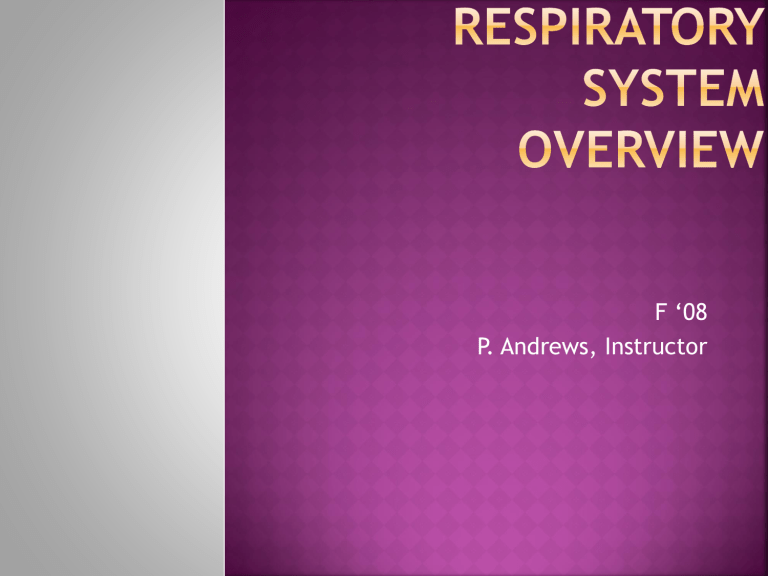093008 no pics Respiratory System Overvi... 90KB Jan 14 2015 08

F ‘08
P. Andrews, Instructor
Respiration
Exchange of gases between an organism and it’s environment
Pulmonary (external) respiration
Occurs in lungs
Cellular (internal) respiration
Occurs in peripheral capillaries
Is the exchange of respiratory gases between RBCs and tissue
Produces CO2
Ventilation
The mechanical process that moves air into and out of lungs
The thorax
Moves air in and out
Oxygen and CO 2 are exchanged
Also contains heart, major vessels, trachea, bronchi, lungs, mediastinum
Ventilations are controlled by a series of centers in the brain and blood vessels
Main control center – medulla oblongata
Connected to respiratory muscles via VAGUS NERVE
Additional control center
– pons
Apneustic center
Pneumotoxic center
Stretch receptors
Decrease inspiratory stimulus
In the medulla and carotid bodies and arch of the aorta
Stimulated by changes in O 2 and CO 2 as well as pH
Hyoxemia is a profound stimulus of respiration in a normal person
People with COPD retain CO
2
– have chronically elevated PaCO
2
Peripheral chemoreceptors become used to this; CNS stops using PaCO
2 to regulate.
A default mechanism – HYPOXIC DRIVE – is activated
Increased respiratory stimulation when PaO 2 falls; inhibited respiratory stimulation when PaO 2 climbs
Major muscles of respiration
Intercostal muscles
Sternocleidomastoid muscles
Accessory muscles are also used
Scalene muscles
Anterior abdominal muscles
Rhomboid muscles
Cough reflex relies on latissimus dorsi muscles
Sternocleidomastoid muscles
raise upper rib and sternum
Intercostal muscles contract
elevate ribs and increase anterior-posterior dimension
Diaphragm is the primary muscle of respiration
– it contracts and flattens
increases volume of cavity.
Pressure in cavity becomes less than atmospheric
air rushes in to alveoli to equalize pressure
Muscles relax…
Diaphragm moves upward
Ribs and sternum move inferiorly
Ribs move closer together in inferior and posterior position
Thoracic volume decreases
Intrathoracic pressure increases
Changing volume and pressure of thoracic cage also helps with
Pumping blood to and return from systemic circulation
Affects BP and pulse strength
Normally, systolic BP and pulse strength fall during inspiration, rise during exhalation
Adults – 12 – 24 breaths per min.
Children – 18 – 24 breaths per min.
Infants – 40 – 60 breaths per min.
Total lung capacity – TLC
~ 6 L
Tidal Volume – V
T
~ 500 ml (5 – 7 ml/kg)
Dead space volume – V
D
~ 150 ml
Alveolar Volume – V
A
~ 350 ml
Minute volume - V min







